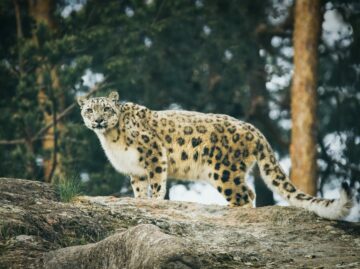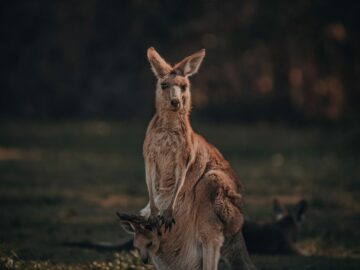Polar bears are one of nature’s most specialized predators. In the harsh, ice-covered waters of the Arctic (up to the North Pole) they sit at the top of the food chain using remarkable evolutionary adaptations that are uniquely theirs. If you want to learn more about these amazing Arctic predators, here are a few interesting facts to get you started.
They Are Well-Built to Survive the Cold Arctic Weather
Courtesy of Pixabay
To survive and thrive in harsh Arctic conditions, polar bears have evolved specific features that help them minimize heat loss and maximize heat gain.
- Underneath all that fur, their skin is black to absorb more heat from the sun.
- Contrary to what most people think, their fur is transparent. This is to allow sunlight to pass through and reach their skin. However, some sunlight still gets reflected by the fur, and this reflected light is what makes their fur look white.
- They have thick fur providing them good insulation from the frigid water and winds.
- They have a thick layer of fat under the skin to minimize heat loss.
- They are big and this helps minimize the skin area-to-volume ratio, allowing more heat to remain in the body while lowering heat lost to the surrounding.
They Are Massive Bears
Among the different bear species in the world, the Polar bear is considered to be the biggest and the tallest. On all fours, an adult polar bear’s shoulders stand about 5 feet from the ground. Even without even standing up, they can stare you in the face at eye level. When they do stand up though, the largest polar bears can reach a height of 10-11 feet and weigh as much as 1,700 lbs (or heavier than 750 kg). This makes them massive creatures and the largest carnivores on land.
They are excellent swimmers
Courtesy of Pixabay
Despite their size, polar bears are surprisingly excellent swimmers. Their hollow, and water-repellent fur together with their buoyant fat layer help counteract their weight. Their large slightly webbed paws make good paddles, while their tapered body shape reduces drag in the water. They can also comfortably swim at a pace of 10 kilometers per hour and have been spotted as far as 100 kilometers offshore. They may not be fast enough to outswim fish or seals, but they are capable of swimming far enough to get from one ice floe to the next in search of unsuspecting seals or of breathing holes that seals use. This is where they ambush their favorite prey, seals. If you want to see how they do it, you can watch it here.
They Can Travel Great Distances
In search of food and sometimes of mates, polar bears can travel as much as 3,000 kilometers in a month. Their territories can range as far as 600,000 square kilometers (an area greater than California) and include bodies of water covered by ice. Despite the temperature, these bears are fine with walking on ice or swimming in frigid waters to cover these huge distances, especially when on the trail of their favorite prey.
They Can Eat a Lot of Fat
Polar bears are known for their appetite and their fat-rich diet. During good seasons, they can consume as much as 100 pounds of blubber in one sitting or as much as 2 kg of fat in a day. To accommodate all these fats, their stomachs can hold as much as 20% of their total body weight.
Fat-rich diet is important because polar bears assimilate most of the fats that they consume to replenish their fat deposits. Even when they are young, polar bear cubs can grow more than 20 times their body weight in just a few months by just gorging on their mom’s fat-rich milk.
They are vulnerable to extinction
Courtesy of Pixabay
Polar bears are now considered a vulnerable species because of their steadily dwindling numbers. Researchers estimate that there are only 22,000 to 26,000 individuals left in the wild, and that number can plummet quickly because of several factors, such as:
- Global warming.
As temperatures around the world continue increasing, the oceans of the world are also becoming warmer and warmer. This is resulting in the melting of ice in the polar regions, effectively decreasing the hunting areas of polar bears. Without the ice, polar bears can not ambush seals and get the valuable blubber that they depend on so much. Also, the few remaining sea ice are getting farther and farther apart to the point where polar bears have to swim several days nonstop just to get to the next one. They now have to wait for winter to have more ice to hunt on when they used to be able to do so all year long.
- Food scarcity.
With less ice to hunt on and less time to hunt, polar bears are forced to change their diets drastically to survive. Since there’s less chance of finding food in the water, they are moving farther inland in search of alternatives, even venturing near human residences to scavenge for food or hunt other prey (which they don’t normally take on like walruses, dogs, livestock).
In some cases, bears (especially males) have been observed cannibalizing their cubs just to get food. You can watch a video of this desperate behavior here.
Frequently Asked Questions
What do polar bears eat?
Their favorite prey, because of the amount of fat available in them, are seals. However, when available, they will also feed on carcasses of other animals like walruses or even whales. Recently, because of global warming, polar bears have been observed scavenging for available food scraps near human dwellings, or even taking on pet dogs or livestock. Cannibalism is also becoming more frequent.
Do polar bears hibernate?
No, they don’t (or at least the males don’t). While other bears hibernate (to survive the winter when food is scarce), polar bears remain active through the winter. Hunting becomes better during this time because the water surface gets covered by ice. This allows polar bears to travel farther and find more breathing holes and ambush spots.
Female polar bears den when they get pregnant, and they remain hidden until their cubs are born and ready to come out. During this time, mommy bears don’t eat (sometimes up to 240 days) to stay with the cubs until they are ready to break free from the dens.
How long do polar bears live?
In the wild, polar bears live around 15 to 18 years. In captivity though, they have been observed to last as long as 30 years or more. A particular polar bear in Canada, named Debby, was able to reach 41 years old before eventually being put down because of multiple organ dysfunction syndrome.







